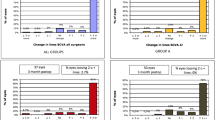Abstract
Aim To evaluate the visual outcome of cataract operations in a Nigerian mission hospital. Methods The computer system cataract surgery record forms were used to collect data on the first 100 consecutive cataract surgeries performed in January and part of February 2003 at a Nigerian mission hospital, Mercy Eye Centre, Abak. Results There were 54 males and 30 females (100 eyes). Sixteen patients had bilateral cataract. The mean age was 58.45 years (SD 13.58). Four patients were hypertensive, 3 diabetic, 2 both hypertensive and diabetic; and also 2 both hypertensive and asthmatic. Four patients had post-uveitic cataract, 3 traumatic cataract, 1 subluxated cataract not related to trauma and the rest had age-related cataract. One patient each had age-related macular degeneration and glaucoma. Only 42 patients (49 eyes) kept with their follow-up visits until 12 weeks post-operatively. Among these, pin hole or corrected visual acuity of 6/6–6/18 was achieved in 35.4%, <6/18–6/60 in 50%, and <6/60 in 14.6%. Almost half of those with poor outcome were attributed to inappropriate selection. Conclusion The main cause of poor visual outcome in our centre is unsuspected co-morbidity. In spite of this, there is potential for good quality cataract surgery in Africa. As we pay more attention to appropriate patient selection we expect our outcome to improve. Provision of facilities for biometry would also be a great help in this direction.
Similar content being viewed by others
References
Adejor GO (1997) Early experience with posterior chamber intraocular lens (PC-IOL) implantation in National Eye Centre, Kaduna, Nigeria. Nig J Ophthalmol 5:6–12
Brain G, Taylor H (2001) Cataract blindness – challenges for the 21st century. Bull World Health Organ 79:249–256
Limburg H, Foster A, Gilbert C, Johnson GJ, Kyndt M (2005) Routine monitoring of visual outcome of cataract surgery. Part I: development of an instrument. Br J Ophthalmol 89:45–49
Limburg H, Foster A, Gilbert C, Johnson GJ, Kyndt M, Myatt M (2005) Routine monitoring of visual outcome of cataract surgery. Part 2: results from eight study centres. Br J Ophthalmol 89:50–52
Pararajasegaram R (2002) Importance of monitoring cataract surgical outcomes. Community Eye Health 15:49–50
Pradhan U, Deshpande S, Grewal PS, Awave M (2003) Intercontinental Medicare project in Ethiopia. Community Eye Health 16:42–43
Thylefors B (1998) A global initiative for the elimination of avoidable blindness. Community Eye Health 11:1–3
Yorston D, Gichuhi S, Wood M, Foster A (2002) Does prospective monitoring improve cataract surgery outcomes in Africa? Br J Ophthalmol 86:543–547
Author information
Authors and Affiliations
Corresponding author
Rights and permissions
About this article
Cite this article
Ezegwui, I.R., Ajewole, J. Monitoring cataract surgical outcome in a Nigerian mission hospital. Int Ophthalmol 29, 7–9 (2009). https://doi.org/10.1007/s10792-007-9182-2
Received:
Accepted:
Published:
Issue Date:
DOI: https://doi.org/10.1007/s10792-007-9182-2




